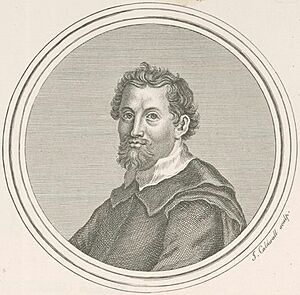Ruggiero Giovannelli facts for kids
Ruggiero Giovannelli (born around 1560 – died January 7, 1625) was an Italian composer. He lived during the end of the Renaissance and the start of the Baroque periods in music. He was part of the Roman School, a group of composers in Rome. Giovannelli took over from the famous composer Palestrina at St. Peter's Church in Rome.
Contents
Life of Ruggiero Giovannelli
Giovannelli was born in Velletri, a town near Rome, Italy. Some people believe he was a student of Palestrina, but there is no clear proof. However, their music sounds similar, and they worked closely together. This makes it seem likely that he learned from Palestrina.
We don't know much about Giovannelli's early life. In 1583, he became a maestro di cappella. This means he was the music director at S Luigi dei Francesi, a church in Rome. He held this job until 1591. After that, he moved to the Collegio Germanico, another important music school. He also worked as a music director for Duke Giovanni Angelo of Altaemps at his private chapel. Giovannelli was also a singer and worked in other management roles.
Giovannelli's most important job was taking over from Palestrina. On March 12, 1594, he became the maestro di cappella at the Julian Chapel in St. Peter's Church. He stayed there until 1599. Then, he became a singer at the Sistine Chapel. In 1614, he became the maestro di cappella for the Sistine Chapel itself. He retired in 1624 and was buried in the church of Santa Marta.
Giovannelli's Music Style
Giovannelli wrote and published many different kinds of music. He is especially known for his church music. Most of his church music still exists today in old handwritten copies.
As a composer from the Roman School, his sacred (church) music was traditional. It sounded a lot like Palestrina's music at first. But after the year 1600, he started trying out new styles. These new styles were part of the beginning of the Baroque era. For example, he used the concertato style, which involved different groups of singers or instruments playing together. He also used basso continuo, a new way of writing the bass line in music.
Later in his life, Giovannelli wrote much less church music. Some experts think this is because he wasn't comfortable with the new Baroque style.
Types of Music He Wrote
Giovannelli wrote masses and motets. A mass is a musical setting of parts of the church service. A motet is a short piece of sacred choral music. Some of his pieces were for as many as 12 voices. He often used polychoral techniques, which means having multiple choirs singing at the same time.
Even though he was a priest and part of the Roman School, he wrote a surprising amount of secular (non-religious) music. This included many madrigals and canzonettas. Madrigals are vocal pieces, usually without instruments, often about love. Canzonettas are lighter, song-like pieces. Some of his secular music was light-hearted, similar to music from northern Italy or by Luca Marenzio. Marenzio was another famous composer who had spent time in Rome.
Giovannelli wrote three books of madrigals for five voices. He also wrote two books for four voices. Many other secular songs he wrote were not put into collections. Most of these songs were written in the 1580s and 1590s.
Giovannelli's music was printed again and again in Italy and other places. This shows that he was very popular during his time.
Published Works
The exact list of Giovannelli's published works can be a bit unclear. However, we know he published several collections of his music.
Some of his known publications include:
- Gli sdruccioli … Il primo libro de madrigali a 4 (Rome, 1585) - This was his first book of madrigals for four voices.
- Il primo libro de madrigali a 5 (1586) - His first book of madrigals for five voices.
- Il primo libro delle villanelle et arie alla napolitana a 3 (Rome, 1588) - A collection of villanelle and Neapolitan songs for three voices.
- Gli sdruccioli … libro secondo a 4, con una caccia in ultimo, 4–8vv (Venice, 1589) - His second book of madrigals for four voices.
- Il secondo libro de madrigali a 5 (1593) - His second book of madrigals for five voices.
- Sacrarum modulationum … liber primus, 5, 8vv (Rome, 1593) - His first book of sacred motets for five and eight voices.
- Terzo libro de madrigali a 5 voci (1599) - His third book of madrigals for five voices.
- Motecta … liber secundus, 5vv (Venice, 1604) - His second book of motets for five voices.
He also wrote other pieces like:
- 3 motets for equal voices
- 17 motets for 3 equal voices called Carmina Sacra
- La Terra, che dal fondo
- O Fortunata Rosa
- Tu nascesti
Some of his madrigals were later used by Aquilino Coppini to create sacred pieces called contrafacta. This means new religious words were put to Giovannelli's existing music. Examples include:
-
- Deus noster fidelis
- O quam inanes
- Sanctissima Maria
- Moritur in ligno
- Suauissime Iesu
- Dulce est & iucundum
- L'Amorosa Ero
Many of his masses, motets, and psalms can be found in handwritten copies at the Vatican Library. These include a Miserere for four and eight voices and a mass for eight voices. This mass was based on Palestrina's madrigal Vestiva i colli. Other madrigals by Giovannelli are in collections by Girolamo Scotto and Phalesisu. His motets and psalms are in collections by Fabio Costantini and Karl Proske.
Midi
- Midi performance of Sancti-Maria


